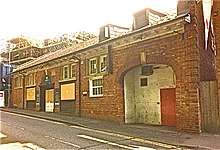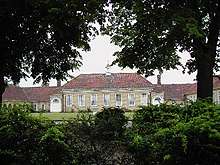Herbert Henry Dunn
Herbert Henry Dunn (c.1865-1935) was an architect who worked in Lincoln in the early 20th century before becoming the surveyor to the Cambridgeshire County Council. He designed buildings in Lincoln and Lincolnshire, before moving to Cambridgeshire shortly before the 1st World War. His most notable buildings in Cambridge are the County Hall which is now part of Christ's College and the Cambridgeshire Shire Hall. Dunn was also the architect for the pioneering Sawston Village College.[1]
Herbert Henry Dunn | |
|---|---|
| Born | c.1865 |
| Nationality | English |
| Alma mater | Articled to William Skill, surveyor, Bailgate, Lincoln 1882-5 |
| Occupation | Architect |
| Practice | St Peter’s Churchyard, Lincoln and then Cambridgeshire County surveyor. |
| Buildings | Cambridgeshire County Hall and Shirehall |
Career
Dunn was articled to William Skill, a surveyor at 58, Bailgate, Lincoln from 1882 to 1885.[2] He then worked in the offices of W. Sindall builder in Cambridge from 1885-7, and then as an improver and later assistant to William Cecil Marshall from 1887-91. He returned to Lincoln to work as an assistant to James Thropp from 1891 to 1896. He qualified ARIBA in 1896 and was proposed by William Watkins , William Milner Fawcett, and William Douglas Caröe. [3] He shortly afterwards set up his own office at St Peter’s Churchyard in Silver Street, Lincoln. He was probably appointed Cambridgeshire County surveyor in 1910, after the death of William Milner Fawcett, who had previously held that position. [4] He became a Fellow of the Royal Institute of British Architects FRIBA in 1925.
Work by H.H. Dunn
In Lincoln and Lincolnshire

- 9-11 The Avenue, Lincoln. 1896. Built by/for Charles Sands, architect H H Dunn. [5]
- Turkish Baths , Corner of Monks Road and Baggholme Road, 97 Monks Road. Built for Mr R W Doughty,[6]
- Lyleston and Northfield, Church Lane, Lincoln. [7]
- 297 High Street/22 Saltergate,Lincoln C. Pratt & Sons former premises on the south side of Clasketgate and 297 High Street (Ann Summers). The block includes the Co-op Bank, the Still and Martin Smith, optician. Brick with stone dressings. The building is showing some of the earliest influence of the Neo-Georgian style in Lincoln with classical pedimented gables and pilasters. The former Lipton premises (adjacent to the High Bridge, by Scorer and Gamble) in the Tudor Gothic style compliments it with the semi-circular oriel corner window.[8]
- De Aston Grammar School, Market Rasen, (1904–08) [9]
- Clubhouse for the Lincoln Golf Club at Torksey 1904. [10]
- Kesteven and Grantham Girls' School, Grantham 1910. (the school at which Margaret Thatcher was educated).[11]
.jpg)
- St Nicholas Vicarage, Newport, Lincoln. 1912. Built for the Rev. Canon Leeke. Arts and Crafts style. [12]
- Former saleroom, Beaumont Fee, Lincoln. Architect Henry Herbert Dunn. Built for J A Cox,1912. Later Big Wok, Chinese restaurant.[13]
In Cambridgeshire
.jpg)
.jpg)
- College of Arts and Technology, Collier Road, 1909. The original building. [14]
- County Hall, Cambridge, 1913-14. [15]

- Sawston Village College. 1930. The earliest of the Cambridgeshire village colleges, in Neo-Georgian style withwith the spreading out type of plan that was that was to be developed in the later colleges. [16]
- Shire Hall, Cambridge, A large Neo-Georgian building in yellow brick. 1931-2. [17]
References
- Brodie (2001), pg 571
- For information on William Skill see Kelly’s Directory of Lincolnshire, 1889, pg. 315
- Brodie (2001), pg 571
- Brodie (2001), pg 637
- Survey of Lincoln: City of Lincoln Building application no 2735, 15 October 1896
- Survey of Lincoln: City of Lincoln Building application no 2983, 15 September 1898
- Survey of Lincoln: City of Lincoln Building application no 3686, 13 November 1902
- Survey of Lincoln: City of Lincoln Building application no 4 February 1903.
- Antram, (1989), pg.326
- Lincolnshire Archives Office Wright Plans/1083
- Antram, (1989), pg.326
- Survey of Lincoln: City of Lincoln Building application no 5090, 13 November 1912.
- Survey of Lincoln: City of Lincoln Building application no 5001, 17 April 1912
- Pevsner, (1970), pg 232.
- Pevsner, (1970), pg 232.
- Pevsner, (1970), pg 454.
- Pevsner, (1970), pg 232.
Literature
- Antram N (revised), Pevsner N & Harris J, (1989), The Buildings of England: Lincolnshire, Yale University Press.
- Brodie A. (ed), Directory of British Architects, 1834–1914: 2 Vols, British Architectural Library, Royal Institute of British Architects, 2001.
- Pevsner N (1970), 2nd ed. The Buildings of England: Cambridgeshire, Penguin, London.
External links
| Wikimedia Commons has media related to Herbert Henry Dunn. |